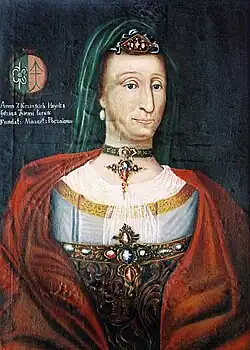Anna Hojska
Anna Hojska | |
|---|---|
 Portrait of Anna Hojska | |
| Known for | Donating lands and the Theotokos of Pochayiv to Pochaiv Lavra |
| Born | Anna Tikhonovna Erofeyeva Kosiñska c. 1530 Grand Duchy of Lithuania |
| Died | c. 1617 |
| Noble family | Kozyñski |
| Spouse(s) | Vasyl Hojski (d. 1581) |
Anna Tikhonovna Erofeyeva Hojska (née Kosiñska, c. 1530–1617) was a Ruthenian noblewoman and patron of the arts and religion. She was a benefactor of the Ukrainian Orthodox monastery Pochaiv Lavra, where she also founded a printing house, donating extensive lands and a miracle-working icon of Theotokos.
Biography
Hojska was born about 1530 and was descended from the ancient Ruthenian (Ukrainian) noble family of Kozyñski.[1] She was married to Vasyl Hojski (died 1581), a judge of Lutsk in the Grand Duchy of Lithuania.[2][3] The couple did not have any children and she remained a widow after his death.
Hojska was a member of the Orthodox Church.[1][4] In 1597, she donated extensive lands and funds to a group of monks so that they could build the lavra monastery: Pochaiv Lavra.[4][5] She also funded the foundation of a printing house there.[1][6]
Hojska donated a miracle working Byzantine Eleusa icon of Theotokos (the title of Mary, mother of Jesus in Eastern Christianity). The icon was given to her by Neophitos of Constantinople in gratitude for staying at her estate near Pochaev during his travels through Volyn lands.[1][6] The icon was said to have cured her brother Pylyp Kozyñski of blindness and she felt that the holy image should not be kept solely for herself.[1][7][8] It became known as Theotokos of Pochayiv, or Our Lady of Pochayiv, and one of the most venerated icons in Ukraine.[9]
Hojska died in 1617.[10]
References
- ^ a b c d e "Pochaev Icon of the Mother of God". Obitel-minsk. Archived from the original on 8 June 2025. Retrieved 10 August 2025.
- ^ Hawryluk, Jerzy (2000). Podlasze: śladami ruskiej przeszłości (in Polish). Podlaskie Wydawn. p. 237. ISBN 978-83-914297-0-9.
- ^ Stecki, Tadeusz Jerzy (1864). Wołyń pod względem statystycznym, historycznym i archeologicznym (in Polish). Druk i nakład Zakładu Nar. im. Ossolińskich. p. 190.
- ^ a b Borkowski, Andrzej (2014). "Początki cenobii na Górze Poczajowskiej i pierwsze donacje na rzecz monasteru". Elpis (in Polish). 16: 173–181. doi:10.15290/elpis.2014.16.21. ISSN 1508-7719. Archived from the original on 3 June 2024. Retrieved 10 August 2025.
- ^ Szulakowska, Urszula (25 April 2022). Art and Architecture in the Eastern Polish-Lithuanian Commonwealth (1697-1863). Cambridge Scholars Publishing. p. 321. ISBN 978-1-5275-8331-3.
- ^ a b Deluga, Waldemar; Zych, Iwona (2004). "Prints from the Pochayiv Monastery". Print Quarterly. 21 (3): 282–289. ISSN 0265-8305. Archived from the original on 11 January 2023. Retrieved 10 August 2025.
- ^ "Pochayiv (Holy Dormition Pochayiv Lavra)". Discover Ukraine. Retrieved 10 August 2025.
- ^ "Почаевская икона Божией Матери". Патриархия.ru (in Russian). Archived from the original on 22 January 2025. Retrieved 10 August 2025.
- ^ Himka, John-Paul; Zayarnyuk, Andriy (30 December 2006). Letters from Heaven: Popular Religion in Russia and Ukraine. University of Toronto Press. p. 208. ISBN 978-0-8020-9148-2.
- ^ "История | Успенская Почаевская Лавра". pochaevlavra.church.ua (in Russian). Retrieved 10 August 2025.